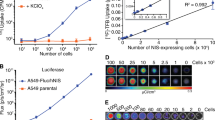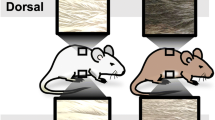Abstract
Bioluminescent imaging (BLI) permits sensitive in vivo detection and quantification of cells specifically engineered to emit visible light. Three stable human tumor cell lines engineered to express luciferase were assessed for their tumorigenicity in subcutaneous, intravenous and spontaneous metastasis models. Bioluminescent PC-3M-luc-C6 human prostate cancer cells were implanted subcutaneously into SCID-beige mice and were monitored for tumor growth and response to 5-FU and mitomycin C treatments. Progressive tumor development and inhibition/regression following drug treatment were observed and quantified in vivo using BLI. Imaging data correlated to standard external caliper measurements of tumor volume, but bioluminescent data permitted earlier detection of tumor growth. In a lung colonization model, bioluminescent A549-luc-C8 human lung cancer cells were injected intravenously and lung metastases were monitored in vivo by whole animal imaging. Anesthetized mice were imaged weekly allowing a temporal assessment of in vivo lung tumor growth. This longitudinal study design permitted an accurate, real-time evaluation of tumor burden in the same animals over time. End-point bioluminescence measured in vivo correlated to total lung weight at necropsy. For a spontaneous metastatic tumor model, bioluminescent HT-29-luc-D6 human colon cancer cells implanted subcutaneously produced metastases to lung and lymph nodes in SCID-beige mice. Both primary tumors and micrometastases were detected by BLI in vivo. Ex vivo imaging of excised lung lobes and lymph nodes confirmed the in vivo signals and indicated a slightly higher frequency of metastasis in some mice. Levels of bioluminescence from in vivo and ex vivo images corresponded to the frequency and size of metastatic lesions in lungs and lymph nodes as subsequently confirmed by histology. In summary, BLI provided rapid, non-invasive monitoring of tumor growth and regression in animals. Its application to traditional oncology animal models offers quantitative and sensitive analysis of tumor growth and metastasis. The ability to temporally assess tumor development and responses to drug therapies in vivo also improves upon current standard animal models that are based on single end point data.
Similar content being viewed by others
References
Killion JJ, Radinsky R, Fidler IJ. Orthotopic models are necessary to predict therapy of transplantable tumors in mice. Cancer Metast Rev 1999; 17: 279–84.
Kerbel RS. What is the optimal rodent model for anti-tumor drug testing? Cancer Metast Rev1999; 17: 301–4.
Gambhir SS. Molecular imaging of cancer with positron emission tomography. Nat Rev Cancer 2002;2: 683–93.
Contag PR. Whole-animal cellular and molecular imaging to accelerate drug development. Drug Discov Today 2002; 7:555–62.
Weissleder R. Scaling down imaging: Molecular mapping of cancer in mice. Nat Rev Cancer 2002; 2: 11–8.
Hoffman R. Green fluorescent protein imaging of tumour growth, metastasis, and angiogenesis in mouse models. Lancet Oncol 2002; 3: 546–56.
Contag CH, Fraser S and Weissleder R. Strategies in in vivo molecular imaging.NeoRev 2000; 1: e225–32.
Contag CH, Weissleder R, Bachmann MH and Fraser S. Applications of in vivo molecular imaging in biology and medicine. NeoRev 2000; 1: e233–e40.
Contag PR, Olomu IN, Stevenson DK, and Contag CH. Bioluminescent indicators in living mammals. Nat Med 1998; 4: 245–7.
Contag CH, Spilman SD, Contag PR, et al. Visualizing gene expression in living mammals using a bioluminescent reporter. Photochem Photobiol 1997; 66: 523–31.
Contag CH, Jenkins D, Contag PR, Negrin RS. Use of reporter genes for optical measurements of neoplastic disease in vivo. Neoplasia 2000; 2: 41–52.
Adams JY, Johnson M, Sato Met al. Visualization of advanced human prostate cancer lesions in living mice by a targeted gene transfer vector and optical imaging. Nat Med 2002; 8: 891–7.
Bhaumik S, Gambhir SS. Optical imaging of Renilla luciferase reporter gene expression in living mice. Proc Natl Acad Sci USA 2002; 99: 377–82.
Sweeney TJ, Mailander V, Tucker AA et al. Visualizing the kinetics of tumor-cell clearance in living animals. Proc Natl Acad Sci USA1999; 96: 12044–9.
Edinger M, Sweeney TJ, Tucker AA et al. Noninvasive assessment of tumor cell proliferation in animal models. Neoplasia1999; 1: 303–10.
Edinger M, Cao YA, Verneris MR et al. Revealing lymphoma growth and the efficacy of immune cell therapies using in vivo bioluminescence imaging. Blood2003; 101: 640–8.
Wetterwald A, van der Pluijm G, Que I, et al. Optical imaging of cancer metastasis to bone marrow: A mouse model of minimal residual disease. Am J Pathol 2002; 160: 1143–53.
Rehemtulla A, Stegman LD, Cardozo SJ et al. Rapid and quantitative assessment of cancer treatment response using in vivo bioluminescence imaging. Neoplasia 2000; 2: 491–5.
Vooijs M, Jonkers J, Lyons S, Berns A. Noninvasive imaging of spontaneous retinoblastoma pathway-dependent tumors in mice. Cancer Res 2002 62: 1862–7.
Contag CH, Contag PR, Mullins JI et al. Photonic detection of bacterial pathogens in living hosts.Mol Microbiol 1995; 18: 593–603.
Rocchetta HL, Boylan CJ, Foley JWet al. Validation of a noninvasive, real-time imaging technology using bioluminescent Escherichia coli in the neutropenic mouse thigh model of infection. Antimicrob Agents Chemother 2001; 45: 129–37.
Burns SM, Joh D, Francis KP et al. Revealing the spatiotemporal patterns of bacterial infectious diseases using bioluminescent pathogens and whole body imaging. Contrib Microbiol 2001; 9: 71–88.
Francis KP, Yu J, Bellinger-Kawahara C et al. Visualizing pneumococcal infections in the lungs of live mice using bioluminescent Streptococcus pneumoniae transformed with a novel gram-positive lux transposon. Infect Immun 2001; 69: 3350–8.
Luker GD, Bardill JP, Prior JL et al. Noninvasive bioluminescence imaging of herpes simplex virus type 1 infection and therapy in living mice.J Virol 2003; 76: 12149–61.
Zhang W, Contag PR, Hardy J et al. Selection of potential therapeutics based on in vivo spatiotemporal transcription patterns of heme oxygenase-1. J Mol Med 2002; 80:655–64.
Zhang W, Feng JQ, Harris SE et al. Rapid in vivo functional analysis of transgenes in mice using whole body imaging of luciferase expression. Transgenic Res2002; 10: 423–34.
Honigman A, Zeira E, Ohana P et al.Imaging transgene expression in live animals. Mol Ther 2001; 4: 239–49.
Carlsen H, Moskaug JO, Fromm SH, Blomhoff R. In vivo imaging of NF-kappa B activity. J Immunol 2002; 168: 1441–6.
Mitchell BS, Horny HP, Adam E, Schumacher U. Immunophenotype of human HT29 colon cancer cell metastases in the lungs of scid mice: spontaneous versus artificial metastases. Invasion Metast 1997; 17: 75–81.
Schumacher U, Adam E, Flavell DJ et al. Glycosylation patterns of the human colon cancer cell line HT-29 detected by Helix pomatia agglutinin and other lectins in culture, in primary tumours and in metastases in SCID mice. Clin Exp Metast1994; 12:398–404.
Author information
Authors and Affiliations
Corresponding author
Rights and permissions
About this article
Cite this article
Jenkins, D.E., Oei, Y., Hornig, Y.S. et al. Bioluminescent imaging (BLI) to improve and refine traditional murine models of tumor growth and metastasis. Clin Exp Metastasis 20, 733–744 (2003). https://doi.org/10.1023/B:CLIN.0000006815.49932.98
Issue Date:
DOI: https://doi.org/10.1023/B:CLIN.0000006815.49932.98




